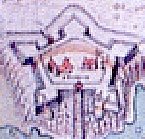

The site where the "Vieux fort" was built has given rise to a controversy amongst the few historians who have expressed an opinion on the subject.
Two places can be seriously considered as probable sites of the first construction work: the south point of the gut, or the plateau to the north-east of the town.
The most generally accepted opinion is that the fort was situated on the south point of the gut, where Fort Frederick was later built.
We more readily support the opinions of the historians who claim that the fort was situated on the flat land to the north- east of the town. We know of two maps and a plan which give evidence of the existence of this French fort at the beginning of the colony; they all place the fort on the plateau to the north-east of Placentia (Figs. 1, 2, 3, 4). As far as the other maps that we have studied are concerned, they simply do not make any mention of it. The census of 1687 is also revealing on the subject. In it there is a statement that the Great Beach, the Little Beach and the fort are all separated by the sea: the mouth of the gut separates the two beaches, while these two beaches are separated from the fort by the harbour. To agree with this description, the fort must, of necessity, be situated on the plateau mentioned above.
As far as geographical situation is concerned, we will also see that, according to the maps, the little fort would be better situated on the hill than at water level. So it is our belief that the "vieux fort" was on the plateau to the north-east of Placentia, that it dates back to a time prior to 1662, and that it was then perhaps reinforced by a battery on the south point of the gut.
Aspect of the Fort
What remains to be decided is what the fort looked like. The only reference to the fort in our possession is the very brief mention of it in Du Perron's letter which tells of a "grande loge de pieux couverte de terre, qui est autant comme rien." At that time there were four cannons in the fort. In 1662-1663, the number was increased to 18, and then to 32 in 1667 when Placentia received a large supply of materials to fortify the place. Apart from this document, we have a plan of the fort, which probably dates back to the middle of the 1670's. However, we doubt that the quality of the fort was as good ten years earlier.
In short, these defence works seem to have been far from perfect and very rudimentary; they amounted to simple earthen ramparts reinforced with stakes. The absence of any serious danger of attack from the outside would seem to explain the simplicity of these defence works. In fact the general rule seems to be that defence is more casual when the threat of attack is less imminent. This rule, which also applies in reverse, applies admirably to the case of Placentia. Towards the end of the decade, England began to present more opposition to French colonization. France reacted accordingly. On September 8, 1669, the minister wrote to Colbert du Terron: "Ayez soin de fortifier aussy de temps en temps la Colonie de Plaisance qui pourra devenir un poste considerable avec le temps." In 1670, La Pioppe replaced La Palme as governor, thus bringing to an end the first stage of the colony's history.